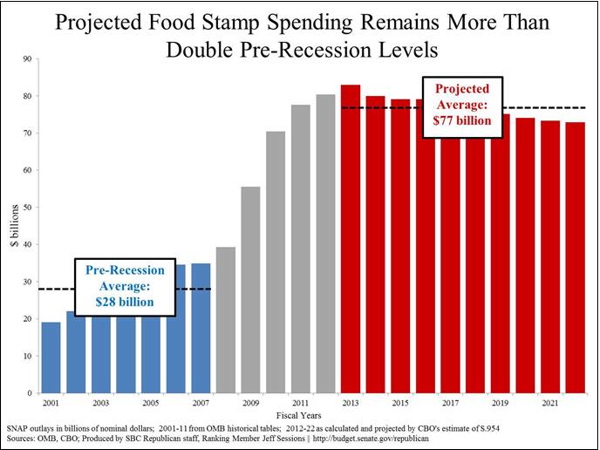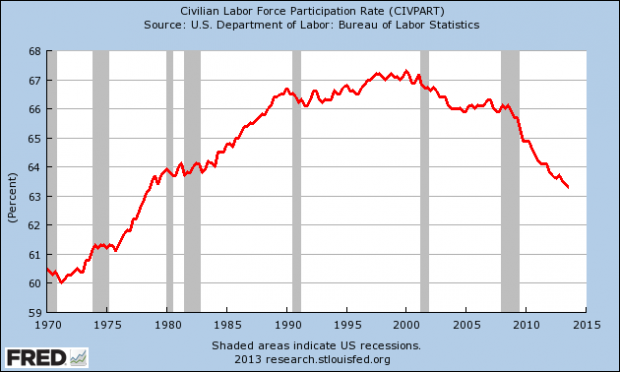Dec. 8, 2013
Analysis: Gov Report Shows 265,000 Net Job Losses Since October
original article written by Net Advisor™
WASHINGTON DC. The U.S. Bureau of Labor Statistics (BLS.gov) just released its latest jobs/ unemployment report on Friday, December 6, 2013 (PDF). The data shows some positive information. However, after taking a closer look and doing further research in this area, we found that the headline number for new jobs was not as rosy as the government made the report out to be. If the stock market’s performance is supposed to be a reflection of the economy, then the U.S. economy should be booming. There seems to be a huge disconnect between the stock market and the economy.
[1] November Jobs Gain: 203,000: BLS.gov
The BLS.gov’s headline shows “total non-farm payroll employment rose by 203,000” in November 2013. The Dow soared +198.69 to 16,020.20; the S&P 500 Index climbed 20 points (or “20 handles” in stock trader speak) to 1,805.09, and NASDAQ moved slightly higher by 26 points to 4,062.52.
[2] October-November Jobs Trend: 265,000 Net Job LOSSES
When taking in account ONLY the November jobs report, the BLS can make the assumption that the “total non-farm payroll employment rose by 203,000.” However, when you look at the total picture from October to November 2013, civilian labor had a total gain of +455,000 in November, but fell by 720,000 in October, creating a net LOSS of 265,000 jobs since October 2013.
“The civilian labor force rose by 455,000 in November, after declining by 720,000 in October.”
— Source: U.S. Bureau of Labor Statistics (P1, Parr 5; Dec. 6, 2013)
[Math: 455,000 (total ‘new’ jobs in November) minus 720,000 (total ‘lost’ jobs in October) = <265,000> job losses from October to November.]
[3] Government Counts for 65.93% Increase November Jobs
Of the jobs gained in November based on the BLS data, U.S. Government workers returning from the temporary shutdown accounted for 65.93% increase in the November 2013 jobs report total.
“The number of persons unemployed less than 5 weeks declined by 300,000 in November, partially reflecting the return to work of federal employees on furlough in October.”
— Source: U.S. Bureau of Labor Statistics (P1, Parr 4; Dec. 6, 2013)
[Math: 300,000 (returning gov jobs) divided by 455,000 (total new jobs) = 65.93. Percent of returning government workers relative to new jobs for November 2013.]
Thus, most of the jobs in November was really just people going back to work after being briefly furloughed. This number could change if there are more workers who were furloughed and who have not returned back to work.
[4] Discrepancy in the November Jobs Report?
We have a dependency in the November jobs report.
When manually adding the net new jobs based on the BLS report here (page 2) we get 171,000 new jobs for November, not the 203,000 being reported. The government could be rounding numbers and excluding smaller gains not listed or specifically categorized in this report. If that is the case it should be noted so anyone can add up the number of new jobs and try and figure out how the government came up with their 203,000 number.
[5] Gov. Not Counting (at least officially) 2.1 Million Unemployed Workers
The BLS.gov report also shows 2.1 million people are not being counted as unemployed. The government claims that this number has decreased by 401,000 in the last year (PDF, p2).
[6] Job Growth: Transportation Up, But is This Temporary?
There were 9,000 job increases in the transportation sector in November, however this could also be seasonal related to holiday shipping. The retail sector saw 22,000 new jobs in November however this could also be temporary for the holiday season. More than 50% new retail jobs occurred in sporting goods – perhaps more people buying firearms, survival and camping gear?
[7] Job Growth
There was job growth in several areas, but we just have not seen the higher earnings or highly skilled jobs out there compared to other sectors.
For example:
Healthcare saw 28,000 increased jobs, however lost we lost -4,000 nurse-related jobs in the same period.
The leisure and hospitality sector which includes travel, hotel, fast food, dining, bars and other drinking places, increased by 18,000 in November. This is the 3rd biggest jobs growth area in the past year. We can conclude that more people are eating and drinking. The problem is for employees, these are typically lower or minimum wage and tip-based jobs.

Caption credit: science.howstuffworks.com. Photo Credit: Tim Boyle/Getty Images.
[8] Gov Considers “Processed Food Making” = to a “Manufacturing” Job
Manufacturing gained 27,000 new jobs in November, however the government considers processed food making as a “manufacturing” job.
Processed food making (“manufacturing”) accounted for 30% (8,000) of all manufacturing jobs in November. So when you hear someone talking about new manufacturing jobs, you need to ask: Are these factory workers making machines or factory workers making things such as cookies or Twinkies?
[9] Jobs Are Always Good News, But People Are Working Less Hours
The average work week for all employees in November was 34.5 hours. Most people would call working less than 40 hours per week, part-time work.
[10] ObamaCare Could Create a Greater Part-time U.S. Economy
The new ObamaCare rules redefined a full-time job as anyone working 35 or more hours per week. Those having 35+ hours per week average during a month and who has an employer with 50 or more employees, the employer is subject to providing mandatory healthcare coverage for qualifying employees under the “Employer Mandate.”
Employers can avoid this costly ObamaCare requirement by having people work less than 35 hours per week on a monthly average. The November labor report puts workers right under this number currently at 34.5 hrs.
[11] Average American Wages for November, Annualized
The average hourly wage in November was $24.15. That works out to be $43,325.10 per year before taxes, based on November average work week of 34.5 hours.
[12] Revised Job Numbers
The BLS.gov revised the September job numbers higher by 12,000 and revised down the October job numbers by 4,000. Still, we have a net 265,000 LOST jobs since October, and the stock market is celebrating?
[13] Unemployment Numbers Conflict
Obama Admin: Unemployment at 7.00%
Gallup Survey: Unemployment at 8.1% with Under-employed Persons at 17.4%
Just two days before the government released its version of the jobs report, the Gallup national polling organization released its employment survey as of Dec. 4, 2013 (PDF).
Gallup’s data showed the U.S. unemployment rate is at 8.1%. The percentage of the U.S. population who are under-employed came in at 17.4%. The percentage of U.S. population who are currently in the labor force is 43.5%.

[14] If Unemployment is Really Going Down, How Come There is a Record Number of People on Food Stamps, and a Record Number of People NOT Working?
The Obama Administration wants everyone to believe that they can keep their health plan, their doctor, their guns, Congress can pass laws, that inflation is low, the deficit is down and many other fantasy arguments that don’t coincide with actions or reality.
So if unemployment is really going down, shouldn’t more people be working? You would think so; but the fact is the St. Louis Federal Reserve (graphic, top of this page) shows the number of people working in the U.S. Labor Force plummeting.
For the last 13 years more people are falling out of the labor force than ever before. This includes during the 8 years in the Bush Administration which included 2 recessions. However, the St. Louis Fed shows Americans rapidly falling out of the labor force under President Obama. The result is contributing to a record increase in welfare such as foods stamps (HTML) (PDF).
[15] Over 91 Million Americans NOT in Labor Force
The Bureau of Labor Statistics reported (PDF highlighted) there were 91.237 Million people in the USA who are NOT in the labor force. If someone is considered not in the labor force from the government’s viewpoint, then they are NOT counted as being unemployed.
So to say the unemployment rate is going “down” when a record number of people are falling out of the labor force, and welfare is skyrocketing, makes this a difficult pill to swallow.
Reporter, Brad Plumer at the Washington Post tried to explain (PDF) that the main reason for the increase in food stamps has to do with the recession: “…It’s the recession — mostly.”
Recession?
Didn’t the FED, the National Bureau of Economic Research, and President Obama all say the recession was over two to four years ago and the economy was improving? If the economy was really improving, why are record numbers of people unable to afford the basics such as food?
[16] Rosy Reporting?
Yahoo! posted an AP article that said, “…Stocks Jump After Strong Jobs Report.” The AP article was very rosy, and didn’t articulate at all, the true breakdown of the jobs numbers, nor did they question the numbers at all.
At the very least, the jobs headline should have been noted that between October and November 2013 we had a net loss of 265,000 jobs. Unicorns for everyone this holiday season.
original article content, Copyright © 2013 NetAdvisor.org® All Rights Reserved.
NetAdvisor.org® is a non-profit organization providing public education and analysis primarily on the U.S. financial markets, personal finance and analysis with a transparent look into U.S. public policy. We also perform and report on financial investigations to help protect the public interest. Read More.


